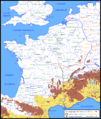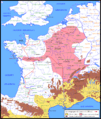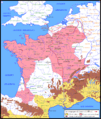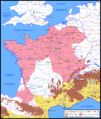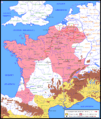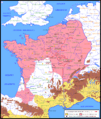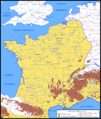The Gallic Wars were a series of military campaigns in which Rome, led by Julius Caesar, fought several Gallic tribes, led by Vercintegorix. The wars lasted from 58 to 50 BC.
Images for kids
-
A modern re-enactor in 2012 wearing the gear that a VII legion standard bearer would have during the Gallic Wars era.
-
The Tusculum portrait of Julius Caesar
-
The campaigns of 58 BC (In Italian). Note the Roman territory in yellow does not yet include modern day France, the Low Countries, or Germany. Caesar's expeditions are a red line, with battles noted. Celtic cities are in green, Germanic cities in orange.
-
Campaign map of 57 BC. Territory conquered the previous year is shaded red.
-
Denarius minted by Decimus Brutus in 48 BC, recalling his service in Gaul. The obverse features the head of Mars, and the reverse shows Gallic carnyces and shields.
-
Campaign map of 56 BC. Note Caesar's foray into the north of Gaul, Crassus' campaigns in the south, and the Battle of Morbihan off the west Atlantic coast.
-
-
Campaign map of 55 BC. Note Caesar's crossing of the Rhine, with Germanic counter movements in orange. Aside from the crossing of the Channel, few other actions were carried out that year.
-
Illustration of the Romans landing in Britain, featuring the standard bearer of the X legion
-
Campaign map of 54 BC. Tribes that revolted have flame icons near their name. Note the Gallic victory over Sabinus in northern Gaul, and Caesar's rush to relieve Cicero.
-
Denarius minted by L. Hostilius Saserna, 48 BC, showing the head of a captive Gaul, and a Britonic chariot on the reverse. Coin Expert Michael Crawford rejects the theory of several historians that the head on the obverse is that of Vercingetorix.
-
Campaign map of 53 BC. Again, revolting tribes are shown with flame icons. Despite having been conquered the prior year, Britain is not shaded in red, as it was not a territorial acquisition: the Britons had only been made tributaries.
-
Vercingétorix's Memorial in Alesia, where he made his last stand
-
Campaign map 52 BC. Most of south and central Gaul is in revolt. Note the Gallic victory at the battle of Gergovia, and Caesar's rush north from Rome.
-
Modern recreation of the Alesia fortifications, featuring rows of stakes in front of a moat, a high banked approach, and regular towers for Roman sentries
-
Campaign map of 51 BC. The last major revolts are put down, and mop-up operations occur in the southwest.
-
Gaul in 50 BC: fully conquered.
-
Gold stater of Vercingetorix, 53–52 BC.
-
-
Denarius from 48 BC, thought to depict an allegory of Gaul with a carnyx on the obverse and Diana of Ephesus with a stag on the reverse
See also
 In Spanish: Guerra de las Galias para niños
In Spanish: Guerra de las Galias para niños
 In Spanish: Guerra de las Galias para niños
In Spanish: Guerra de las Galias para niños



